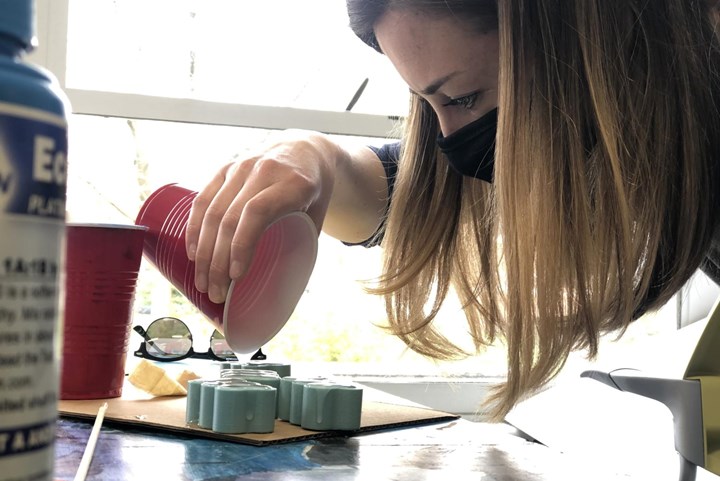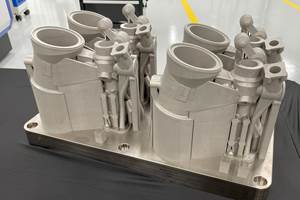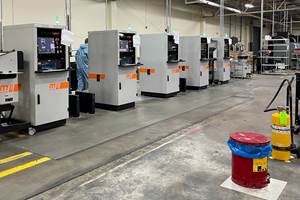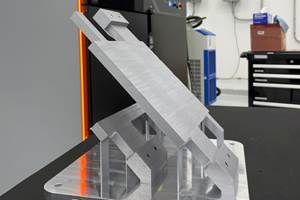Is Additive Freeing Designers or Aiding Manufacturers?
How can we embrace additive manufacturing within an enterprise? Timothy Simpson says we need to change our mindset.
Share
Jessica Menold, assistant professor of engineering design, manufactures silicone earbuds for single-use stethoscopes using silicone rubber molds formed from 3D printed earbuds. Photo credit: Christian Baum. All rights reserved.
I hope you are sitting down for this one: I have recently come to the conclusion that the people advancing and promoting additive manufacturing (AM), including me, may have been marketing it wrong and even marketing it to the wrong people.
Yes, AM has successfully solved the “prototyping problem” and has shown its strength during the pandemic, but AM is most often advertised, marketed and sold touting the benefits of “free complexity,” design freedom, material freedom, lightweighting, bio-inspired design and so on. These are all design problems, not manufacturing problems. The AM community has been so busy freeing the designers that we forgot about aiding manufacturers. As a result, the primary channels that have emerged target product development and engineering — not the process engineers, machining professionals and myriad other people working in a manufacturing enterprise. As my cartoon namesake father would say, “D’oh!”
I’m equally guilty of this and have unfortunately been perpetuating it with my own students for nearly 25 years — sorry! My background is mechanical engineering and product design, and my views and perspectives on AM have been shaped accordingly since 3D printing technology hit the market when I was an undergraduate in engineering. Consequently, my columns have mainly focused on all of the design (and material) benefits of AM, explaining the different AM processes and their benefits, and sharing the challenges with post-processing, high costs, need for new AM standards and so on. I’ve shared insights from my own AM experiences, adventures and failures, and I have tried my best to identify ways that traditional manufacturing experts can help AM in hopes of welcoming them into AM and dispelling any fears of using it. Heck, my very first column was a plea to the machining professionals to help AM solve all of its problems.
But a lot has changed over the past decade, particularly with metal AM technology. I have been fortunate to be at the forefront of a lot of this development while serving as co-director of a leading AM research facility at Penn State, CIMP-3D. Needless to say, I have learned a ton about things I previously had little knowledge of — things I didn’t even know to ask or look for. I have also been fortunate to be part of The Barnes Global Advisors for five years now, and it has been eye-opening to work with a team of industry experts that have actually designed, manufactured, qualified, certified and flown metal AM parts. We frequently joke that Chelsea Cummings is the “jaded process engineer” when she and I coteach, but she has qualified an AM part for aerospace — not me! I learn something new from her every time we talk.
Most recently, I was fortunate to be able to lead Penn State’s response to address shortages of personal protective equipment (PPE) and other supplies for healthcare professionals. I have written about my Manufacturing And Sterilization for COVID19 (MASC) effort often, but one of the biggest “lessons learned” for me in running a team of 400 people was how far AM still needs to come to be “industrialized” in many cases.
The MASC team grew from my network of AM and 3D printing friends and colleagues, first at Penn State, then at Hershey Medical Center, then across the Commonwealth of Pennsylvania. We used AM in every way that you can imagine and have read about, and in the end, the best uses for AM come from aiding manufacturing, not maximizing design freedom or exploiting a lattice structure. Sure, we did that, but only to save material to reduce costs and shorten print time to make an AM solution viable. Unfortunately, nine times out of 10, AM wasn’t the best, fastest, cheapest way to manufacture a part. Not even close.
There were wins though. AM gained immediate traction within MASC when it helped 3D print fixtures and tooling to aid production and assembly, made molds to pour silicone earbuds for single-use stethoscopes (see image) and consolidated multipiece assemblies into a single AM part to save labor costs and reduce takt time.
AM for injection molded tooling? Maybe, but there is a high risk and high cost associated despite being faster. AM to mass produce 3D printed face shields and filtration masks? Too expensive and too slow unless production is already at scale. AM for replacement parts and spares? Maybe, but only if the materials are compatible, sterilizable and adhere to FDA cGMP regulations. Needless to say, I learned a lot as I tried to put my AM knowledge into action, and it has reframed my thinking. Combine that with all the online AM training I’ve been presenting, and my entire mindset about what we teach has shifted. Likewise, so has my column.
Here is where I need your help. What are some of the primary “pain points” you experience in manufacturing? We talk about production aids, fixtures and the like, but what do you really wish you had next to you on the mill or lathe? On the factory floor? On the assembly line? In the paint booth? I currently have 10 “buckets” in mind for how AM might aid manufacturing, and I hope your examples both corroborate and expand my list. Feel free to connect on LinkedIn or via email at Penn State. And don’t worry, I won’t publicly share anything you send without your permission. Meanwhile, let’s start talking about how AM can aid manufacturers, not just free those product designers and engineers.
Related Content
Why AM Leads to Internal Production for Collins Aerospace (Includes Video)
A new Charlotte-area center will provide additive manufacturing expertise and production capacity for Collins business units based across the country, allowing the company to guard proprietary design and process details that are often part of AM.
Read MoreAdditive Manufacturing Production at Scale Reveals the Technology's Next Challenges: AM Radio #28
Seemingly small issues in 3D printing are becoming larger problems that need solutions as manufacturers advance into ongoing production and higher quantities with AM. Stephanie Hendrixson and Peter Zelinski discuss 6 of these challenges on AM Radio.
Read MoreWhat Does AM Want? Here Are 4 Aims (Maybe 5) That Additive Manufacturing Is Driving Toward
Certain freedoms and contributing factors allow additive manufacturing to realize its full promise for production.
Read MoreVulcanForms Is Forging a New Model for Large-Scale Production (and It's More Than 3D Printing)
The MIT spinout leverages proprietary high-power laser powder bed fusion alongside machining in the context of digitized, cost-effective and “maniacally focused” production.
Read MoreRead Next
To Improve Performance of Compression Molded Composites, Add 3D Printed Preforms
9T Labs' Additive Fusion Technology enables the manufacture of composite structures with as much or as little reinforcement as is necessary, using 3D printed continuous fiber preforms to add strength just where needed.
Read More3D Printing Brings Sustainability, Accessibility to Glass Manufacturing
Australian startup Maple Glass Printing has developed a process for extruding glass into artwork, lab implements and architectural elements. Along the way, the company has also found more efficient ways of recycling this material.
Read MoreLooking to Secure the Supply Chain for Castings? Don't Overlook 3D Printed Sand Cores and Molds
Concerns about casting lead times and costs have many OEMs looking to 3D print parts directly in metal. But don’t overlook the advantages of 3D printed sand cores and molds applied for conventional metal casting, says Humtown leader.
Read More














.png;maxWidth=300;quality=90)









